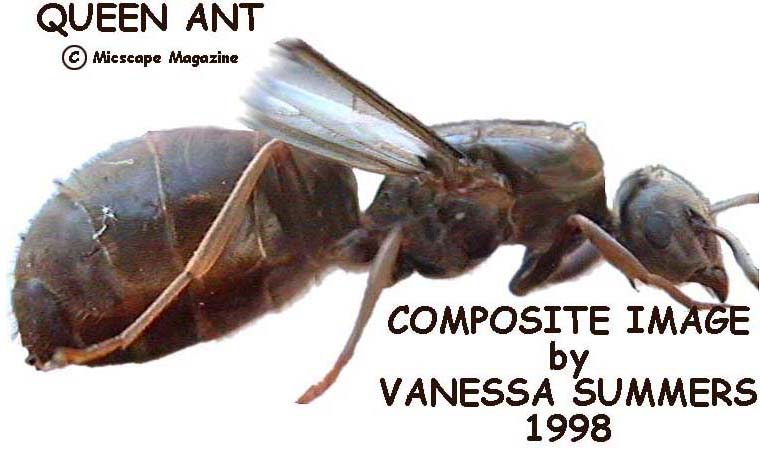
Ants in yer Pants - Page 3 GOTO START OF ARTICLE!

| Once you have
seen a Queen Ant and the sheer size of her, you realize
her unique importance to the survival of the ant species.
You will have seen Queen Ants even if you don't know it.
Remember how on a
humid day the air suddenly becomes filled with flying
ants? You do..? The flying ants are really queens and male ants mixed together - the latter bred specially for this flight. The males will not live long. Their purpose is to fertilise the queens and once their job is done, they will land, exhausted, and die. The queens will survive, storing the male-ant generated sperm to use over the next few years to fertilise her eggs. She is the ultimate baby-laying machine! All the ants of a similar species in a specific area tend to 'launch' their queens and males on this spectacular flight at precisely the same time... which is a remarkable achievement: males reared in the nests specifically for this occasion must be ready for the day. How do all the different nests in quite a wide area know how to synchronize the development of the males to be ready at a common time? What common thing signals to each nest to begin the flight? The only common factor is the environment itself. It is believed that humidity and temperature are involved but the precise mechanism is still little understood! When the queen completes her mating flight, she will land, find a place to start her nest and then rear the first ants (all female) herself. When these are strong enough, they will support the queen and help her by rearing and tending for the successive generations of 'children' the queen will give birth to. The queen lays all the fertilised eggs and all the matured ants help to ensure the eggs hatch, off-spring are fed, and the nest is kept safe and sound. As a woman, I can't help feeling some kind of remote sympathy for this 'titanic' female who's sole purpose in life is to lay there giving birth for months and years on end. Because ants are small, and to all extensive observations, lack the sophisticated awareness of humans - we tend to think of them as robots: this is a completely wrong perception! Ants are living animals. They can feel pain and they can feel pleasure. It is only human arrogance which probably reduces their 'feeling' experiences into something less. We may well talk of 'responses' and 'reactions' but if you consider these adjectives when applied to ourselves, they translate as 'feelings' and 'emotions'. With social insects like ants, behaviour of individuals is designed to benefit the nest of ants as a whole. Co-operation, and division of labour, is paramount to their success - just like us humans. These are one of the most interesting life-forms you can study, alive, and with very little in the way of magnifying equipment. So little is still known about their complex behaviour even though many books have been written about them. Ants and bees share much in common - sharing similar social habits, and have evolved from a single source. Larry and I find them still to be one of favourite study areas... and I am sure, once you start to get closer to them and look for yourselves - you will be rewarded with great insight and probably much compassion and respect for their endeavours. What
wonderful creatures they are! |
(c) Microscopy UK & Micscape magazine Contributors 1998
All rights reserved in the interest of the contributors,
Comments to : the author Vanessa Summers
Visit Larry
and Vanessa's Web-site to
explore their microcosmic world